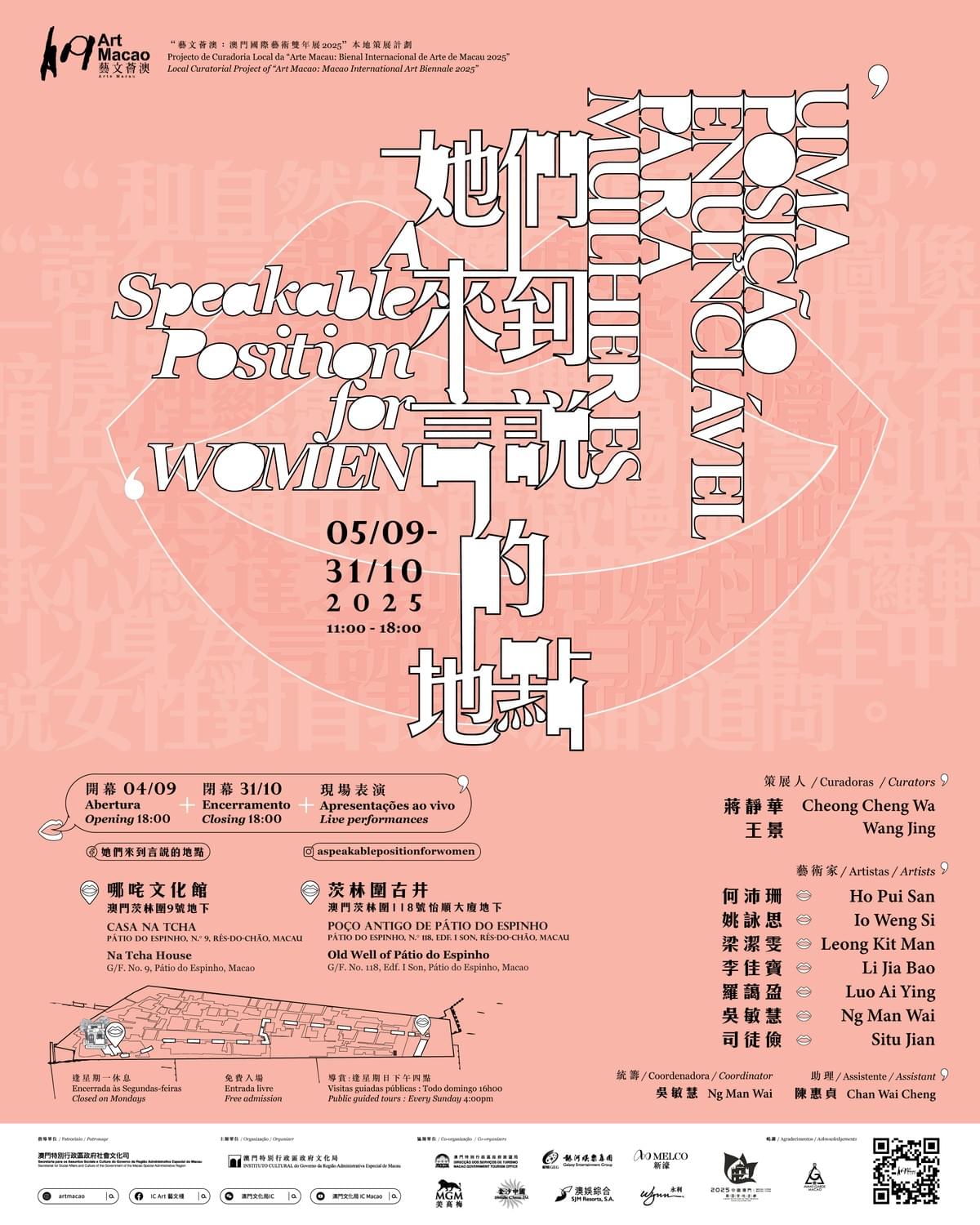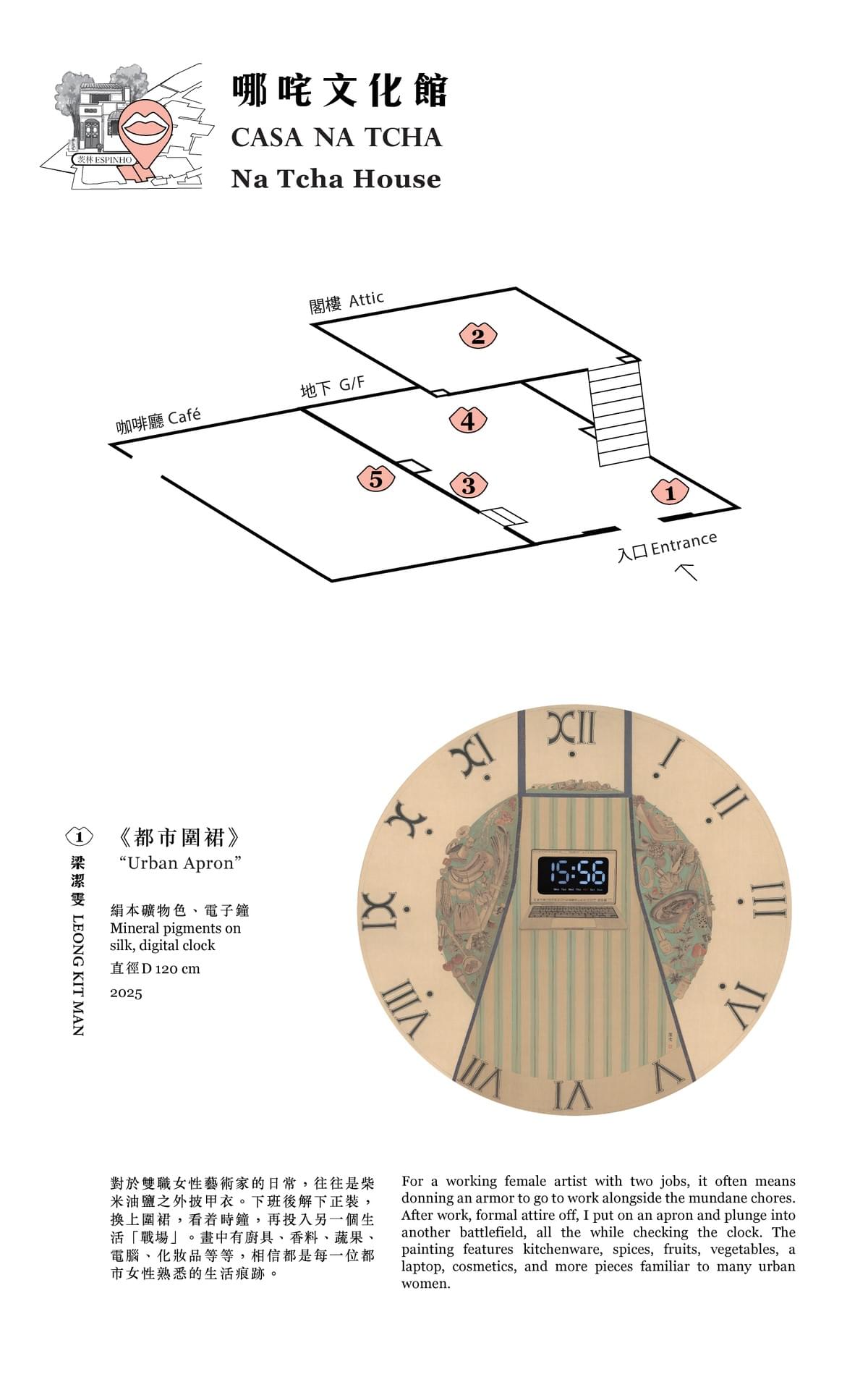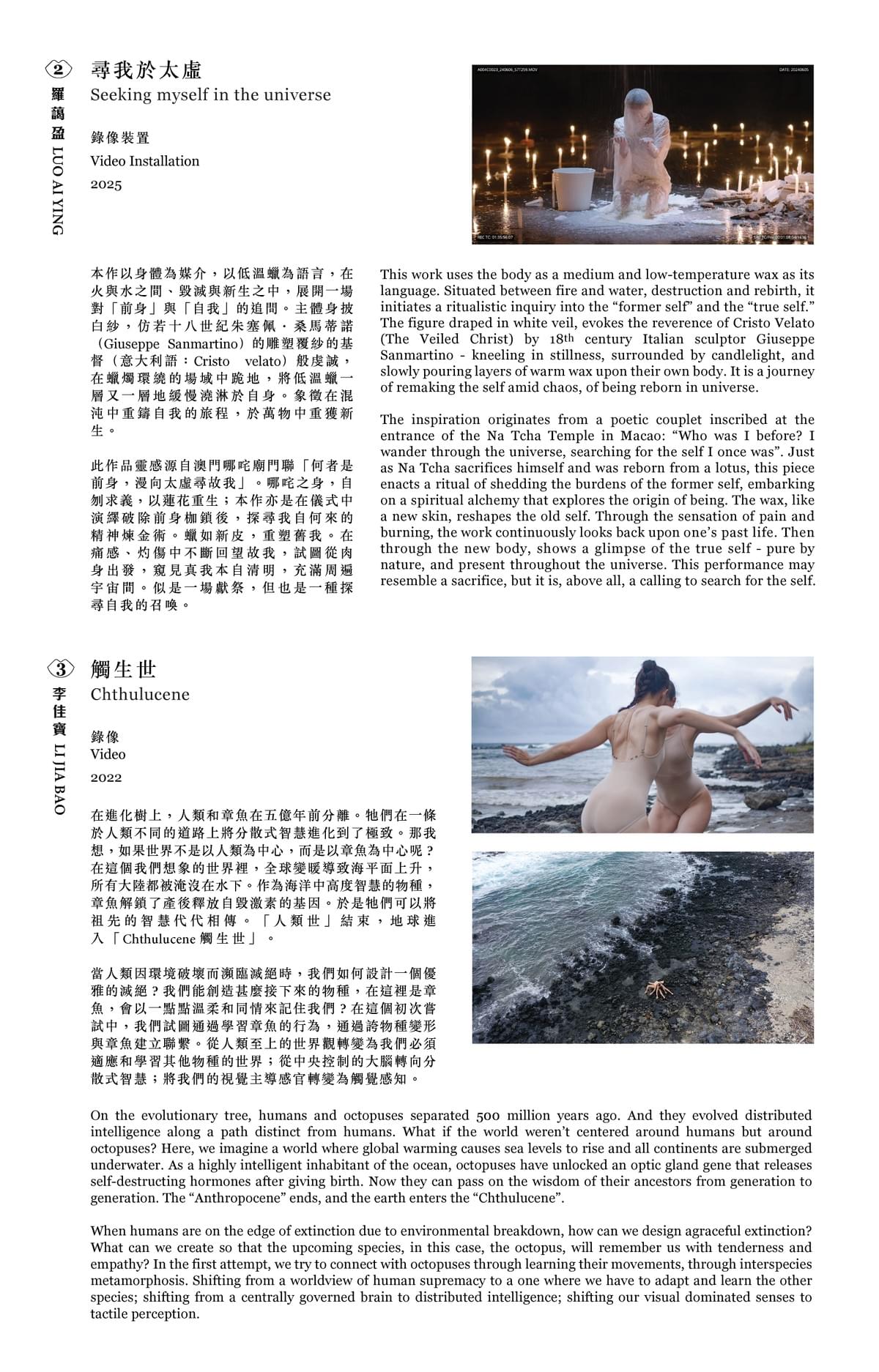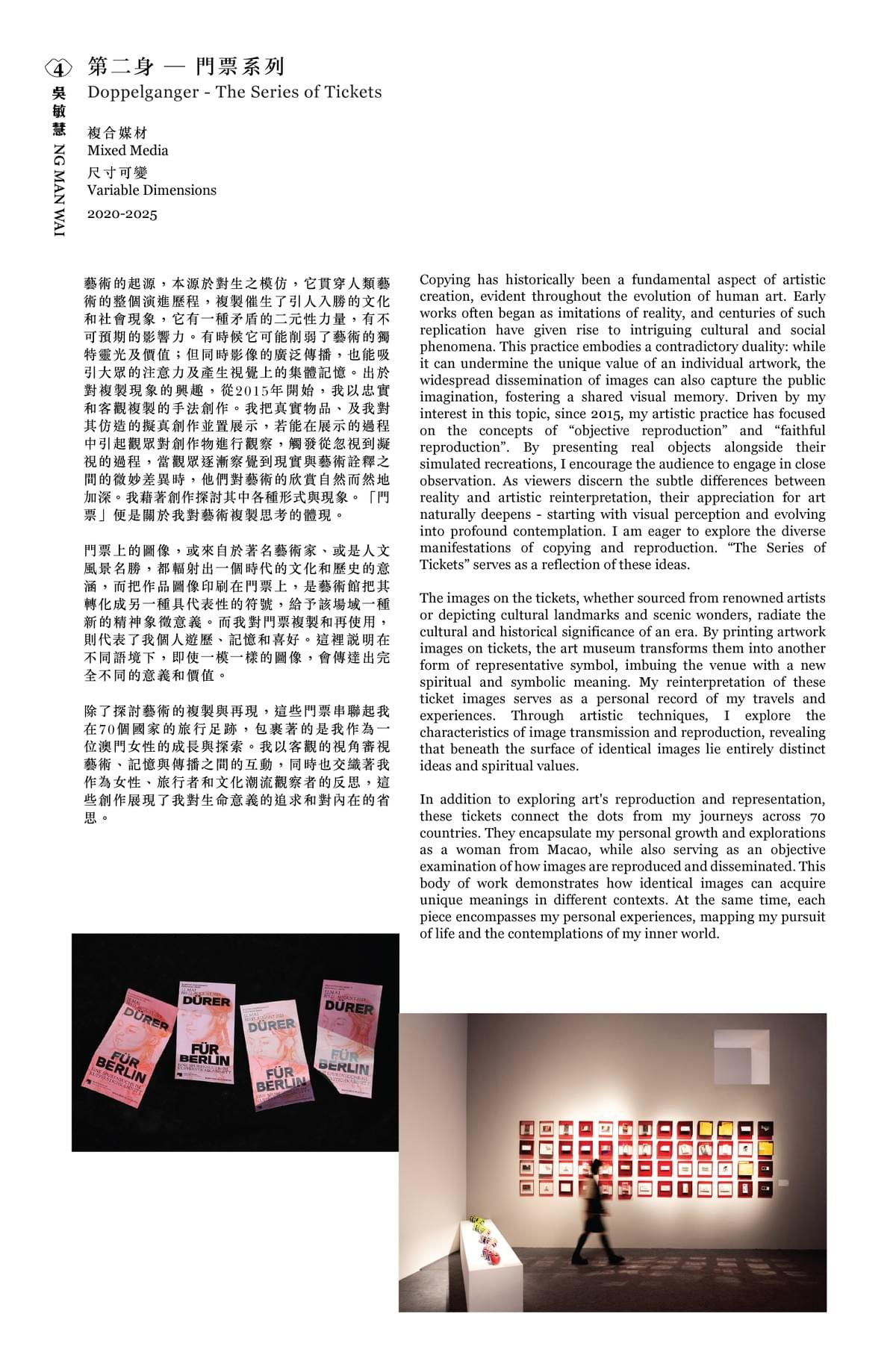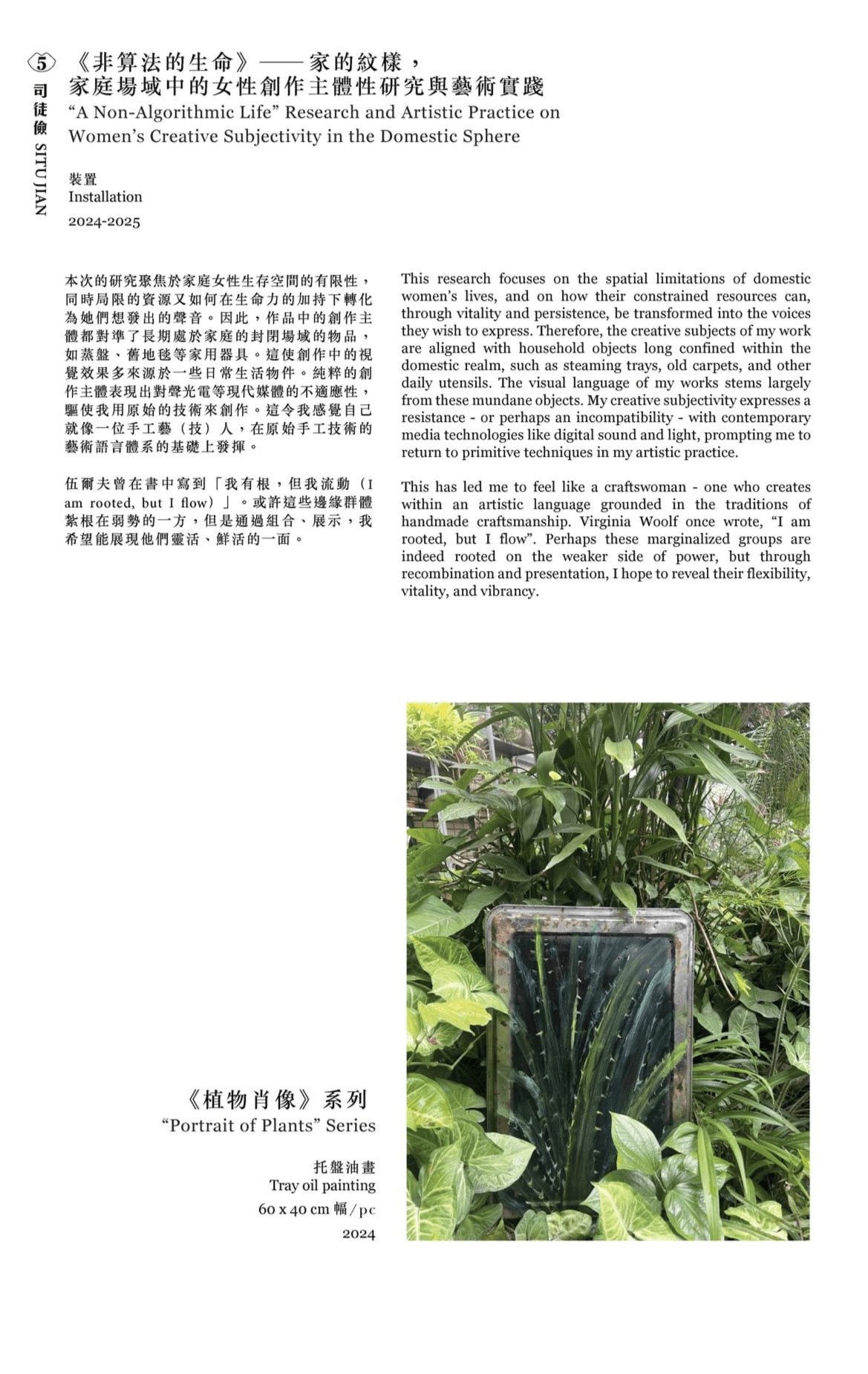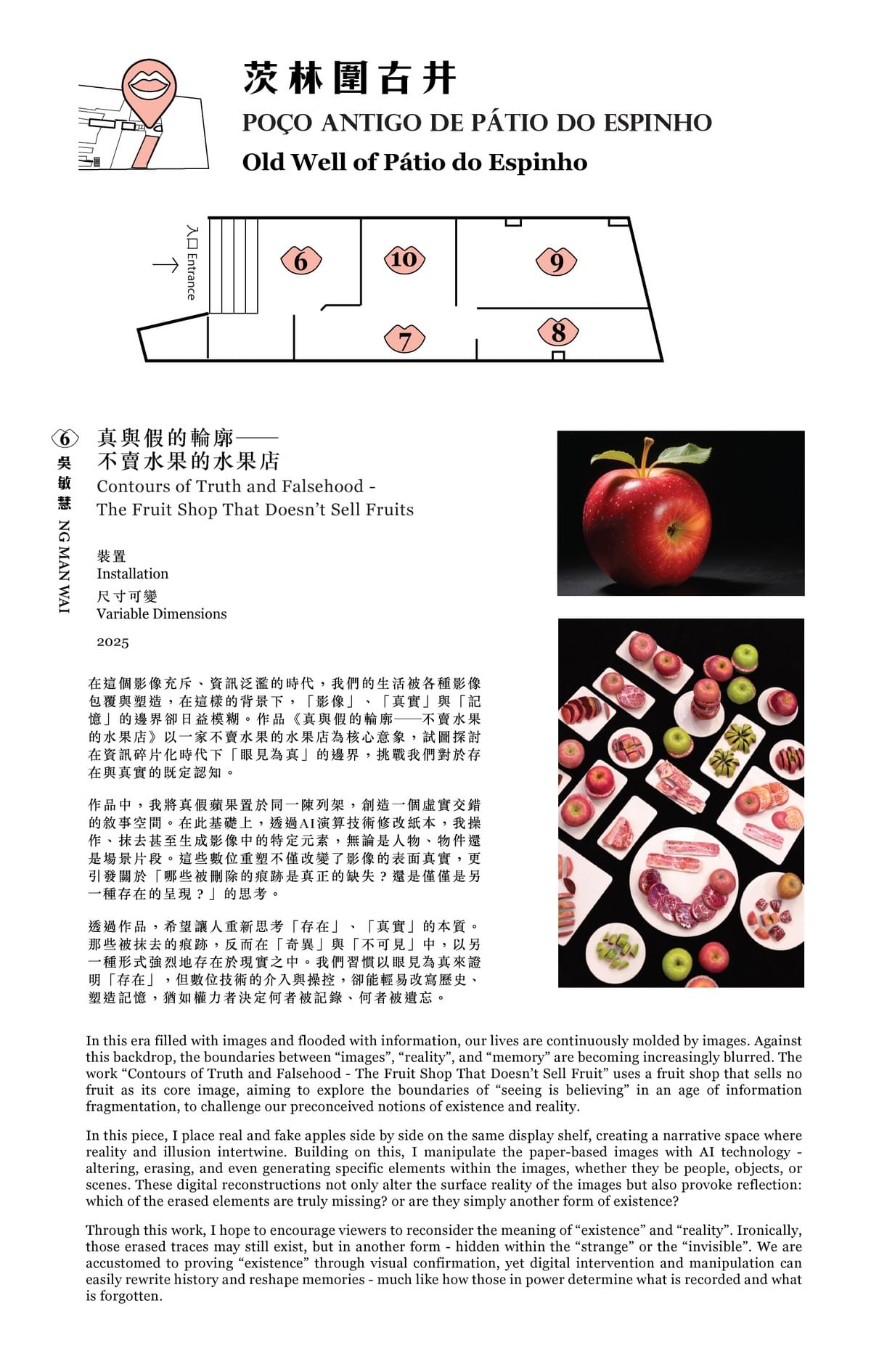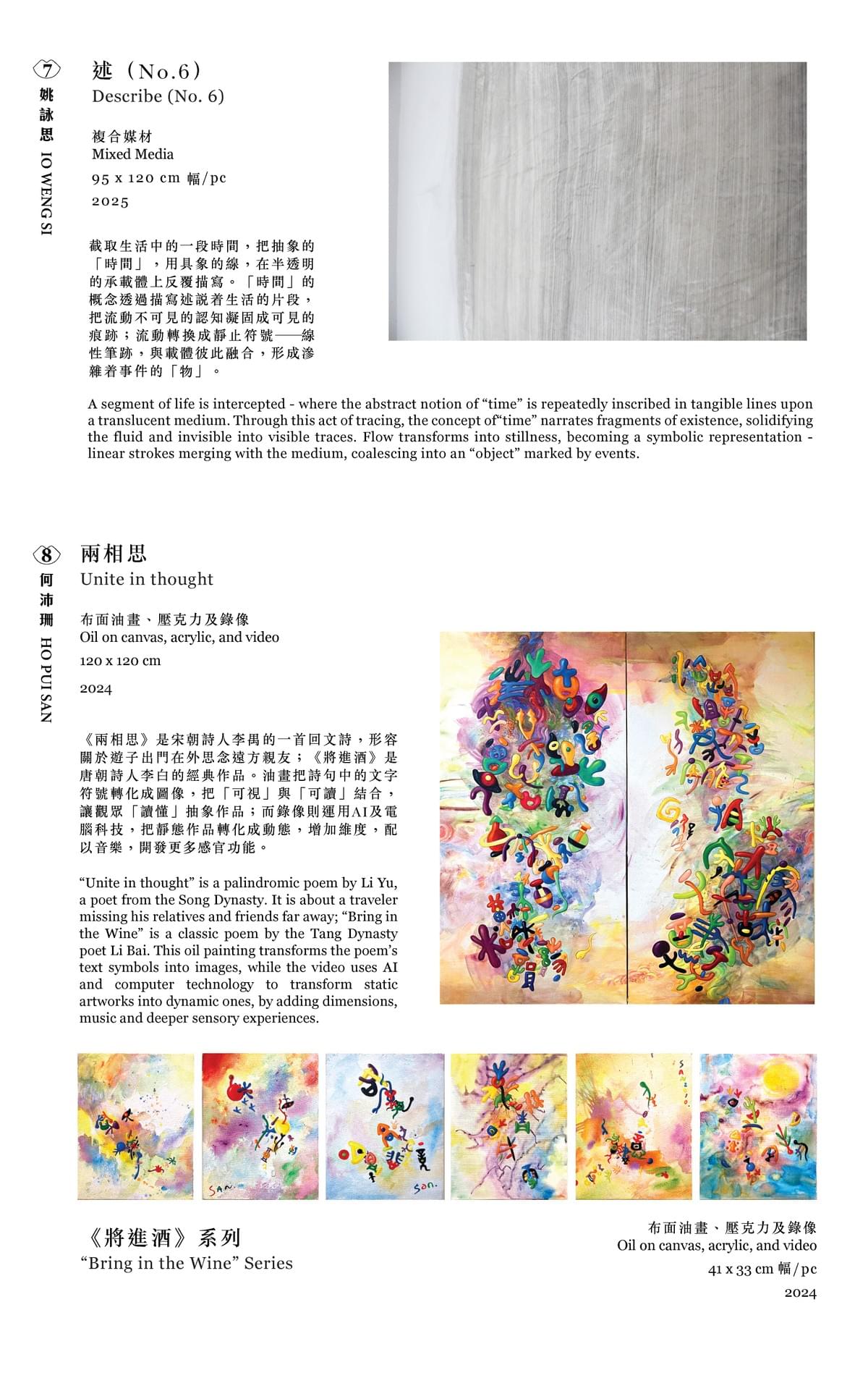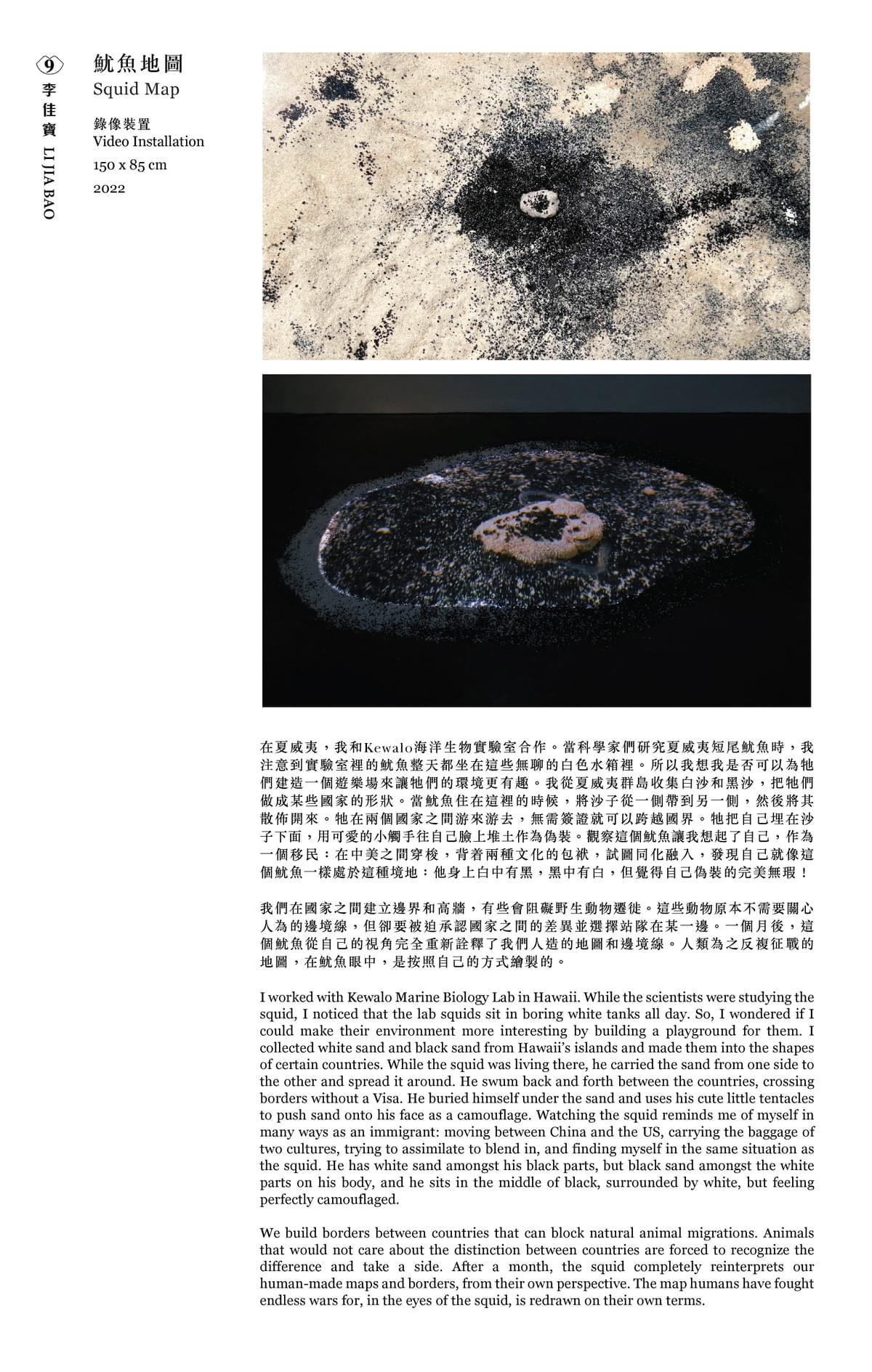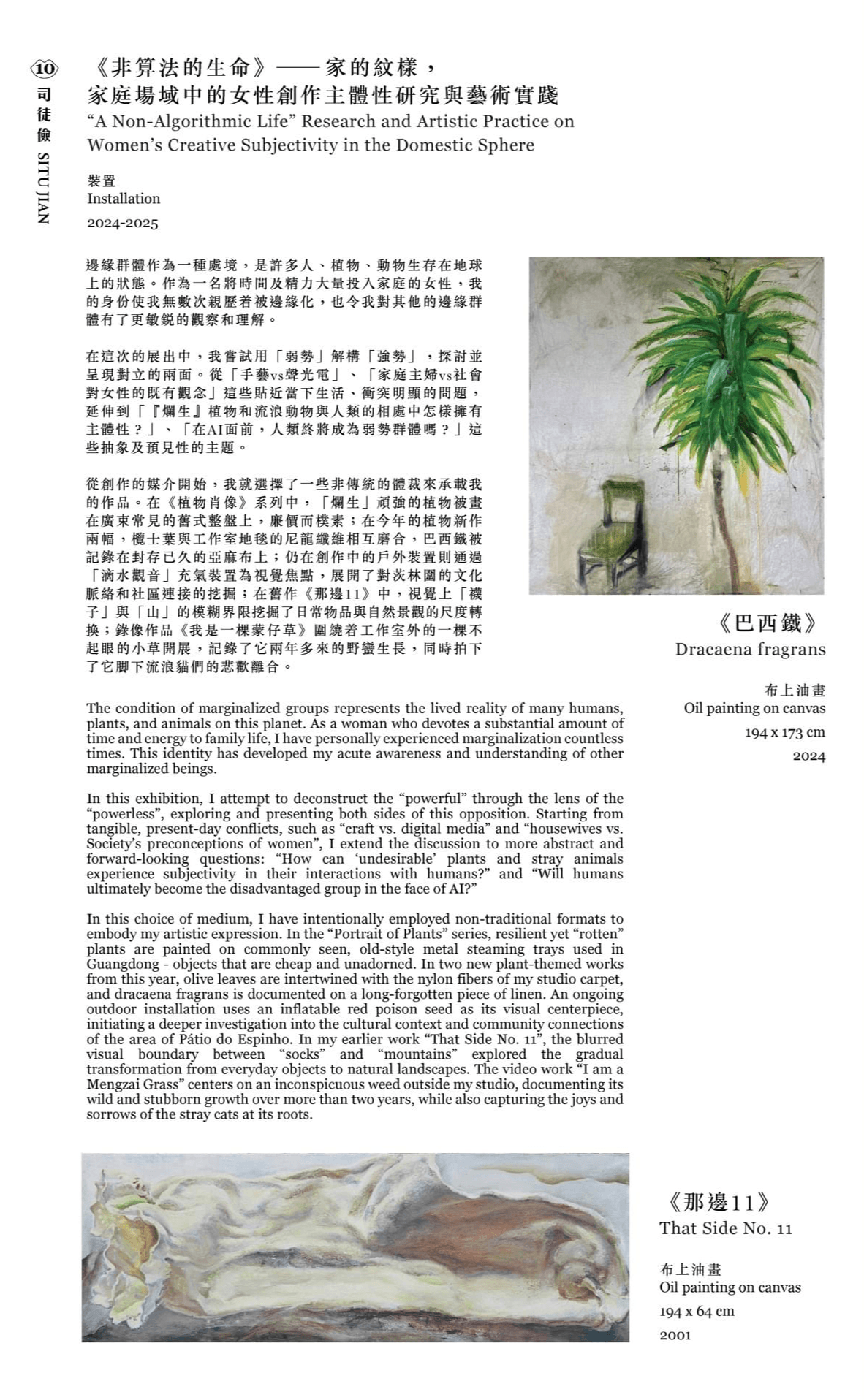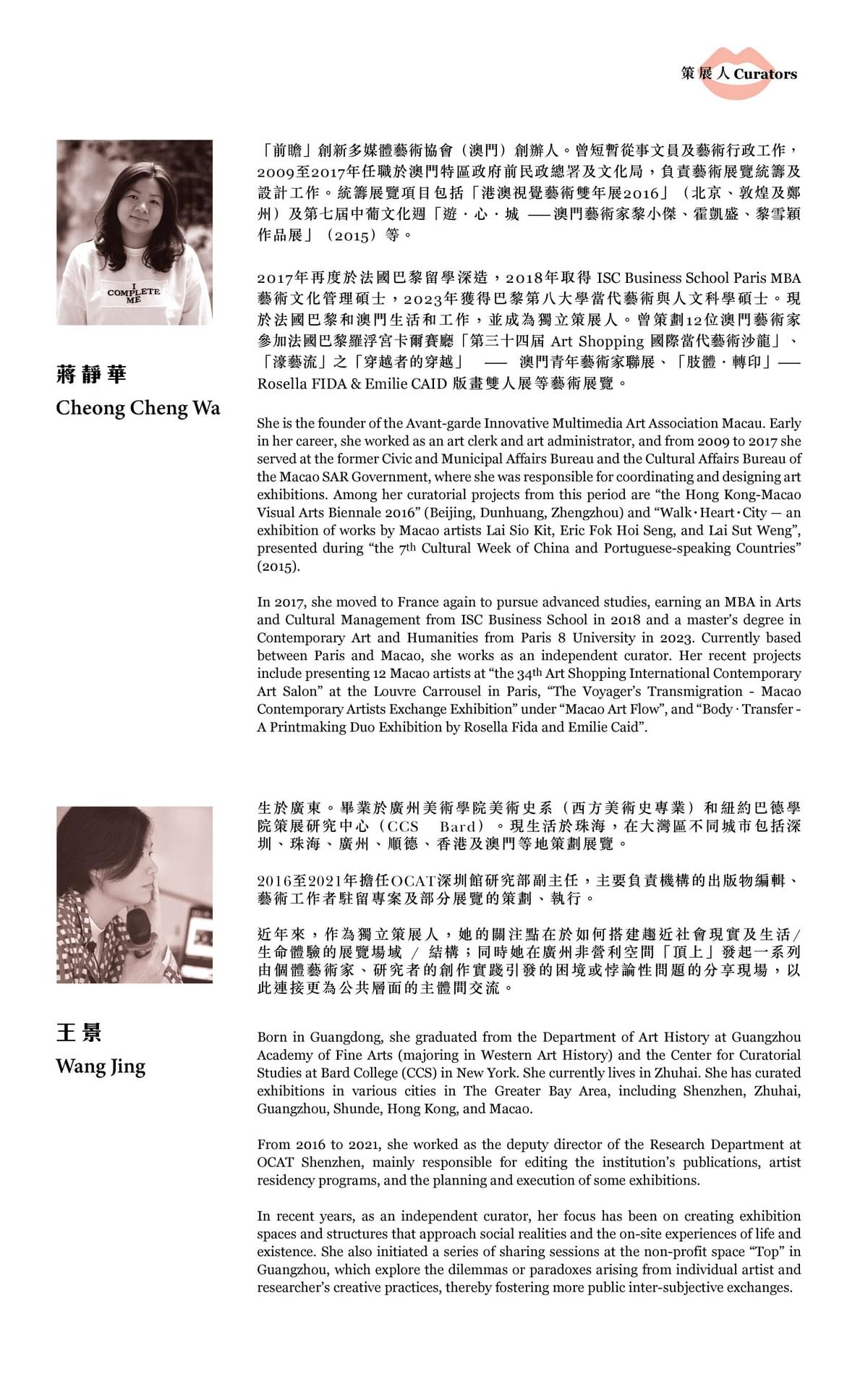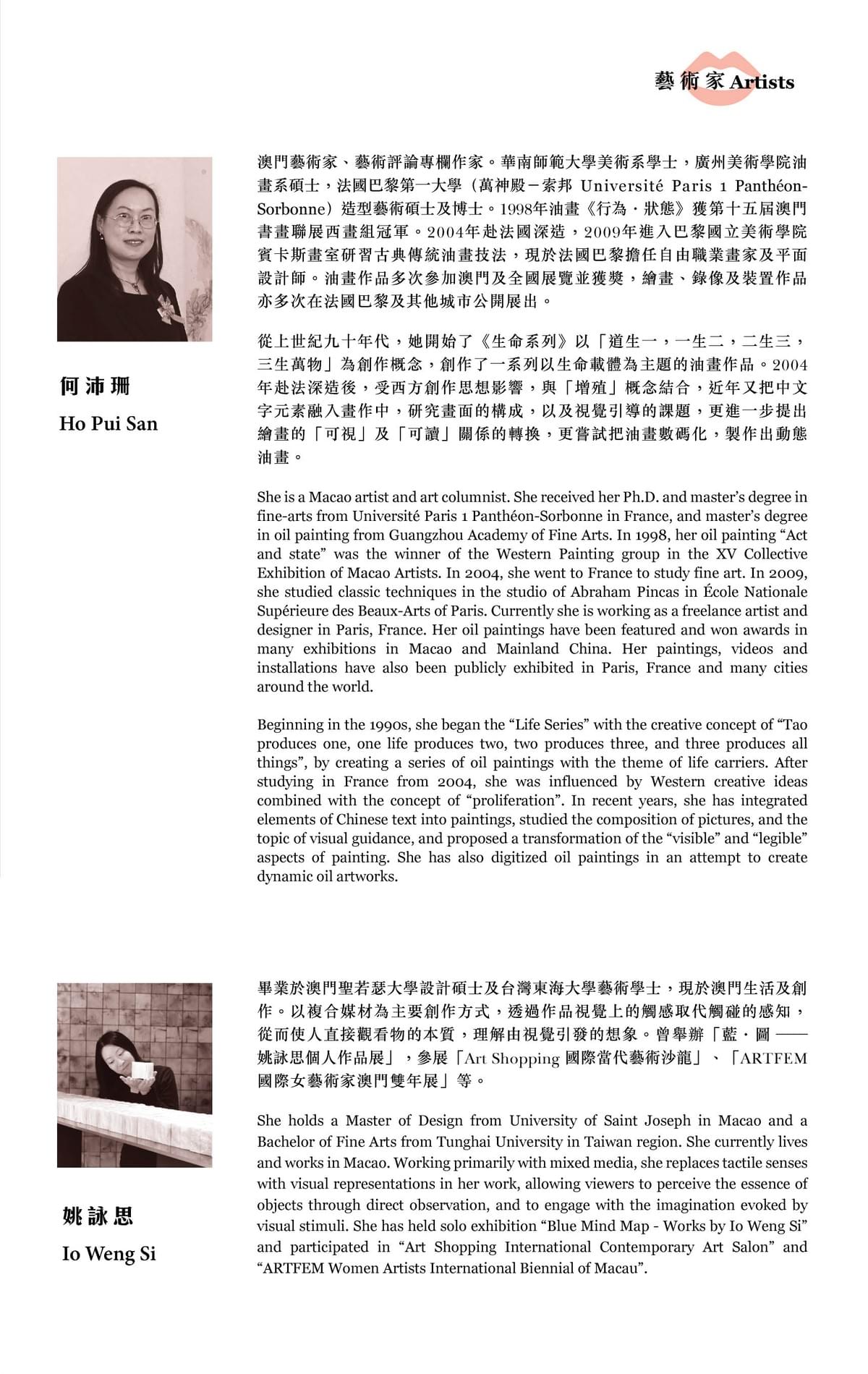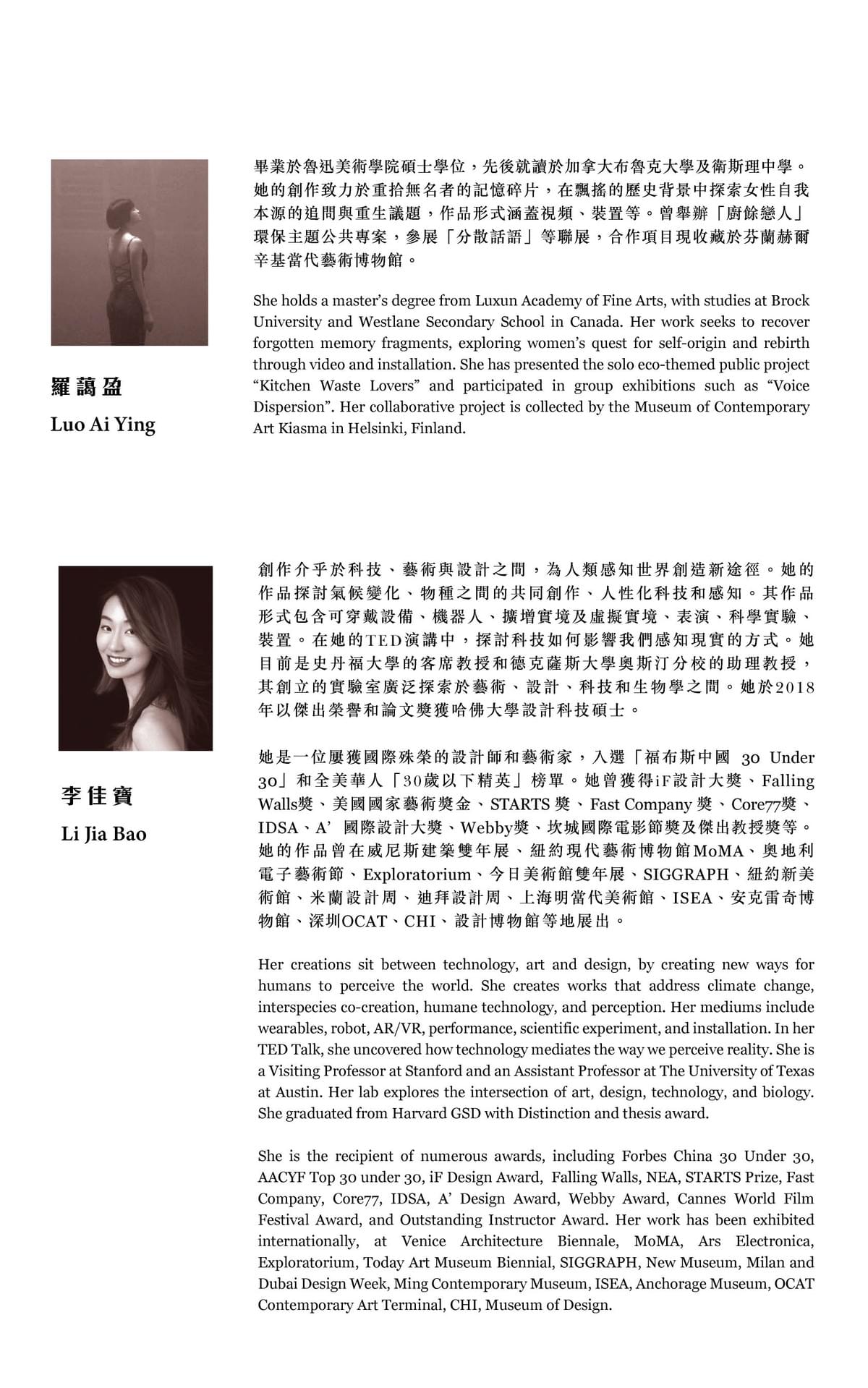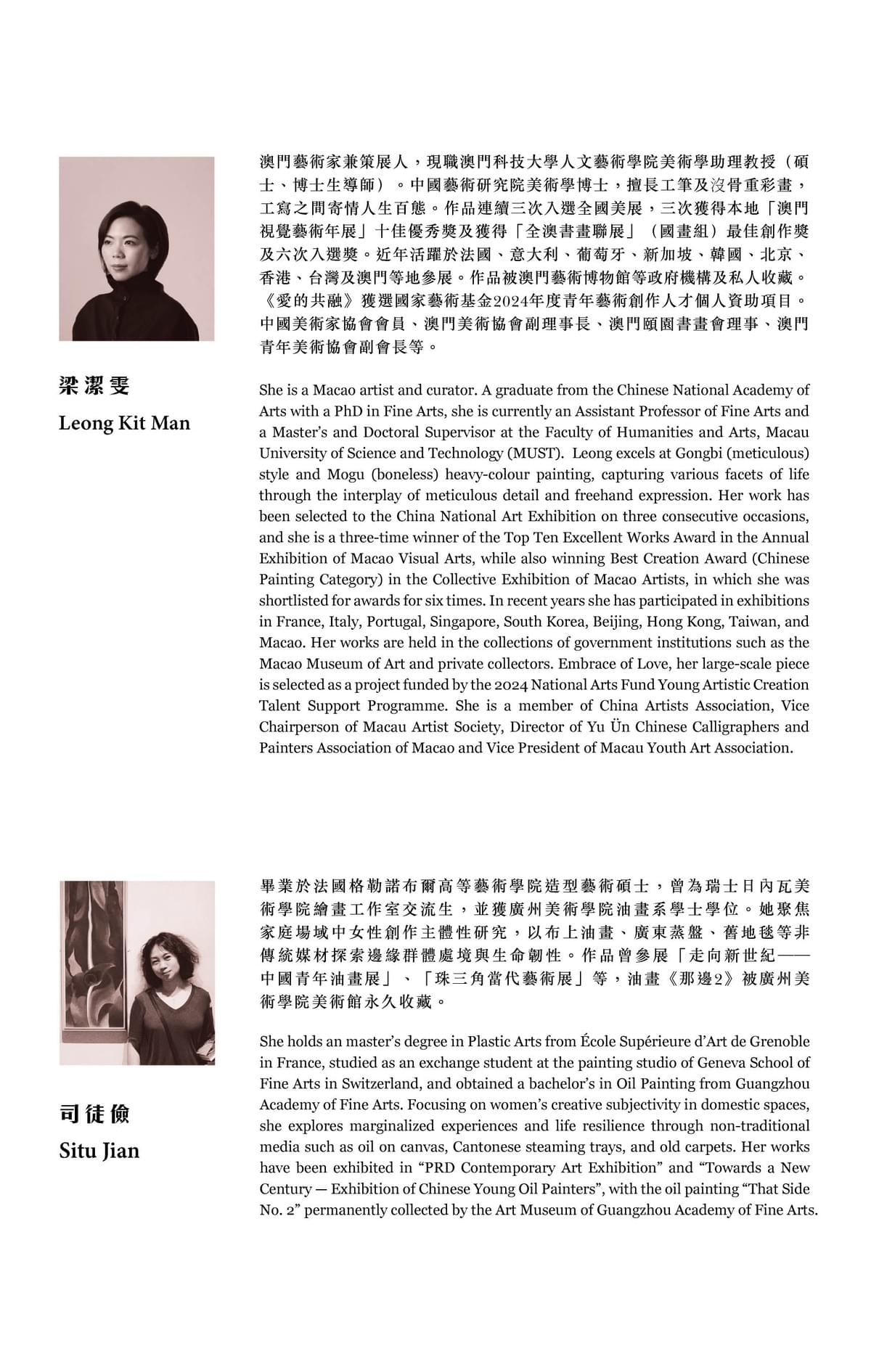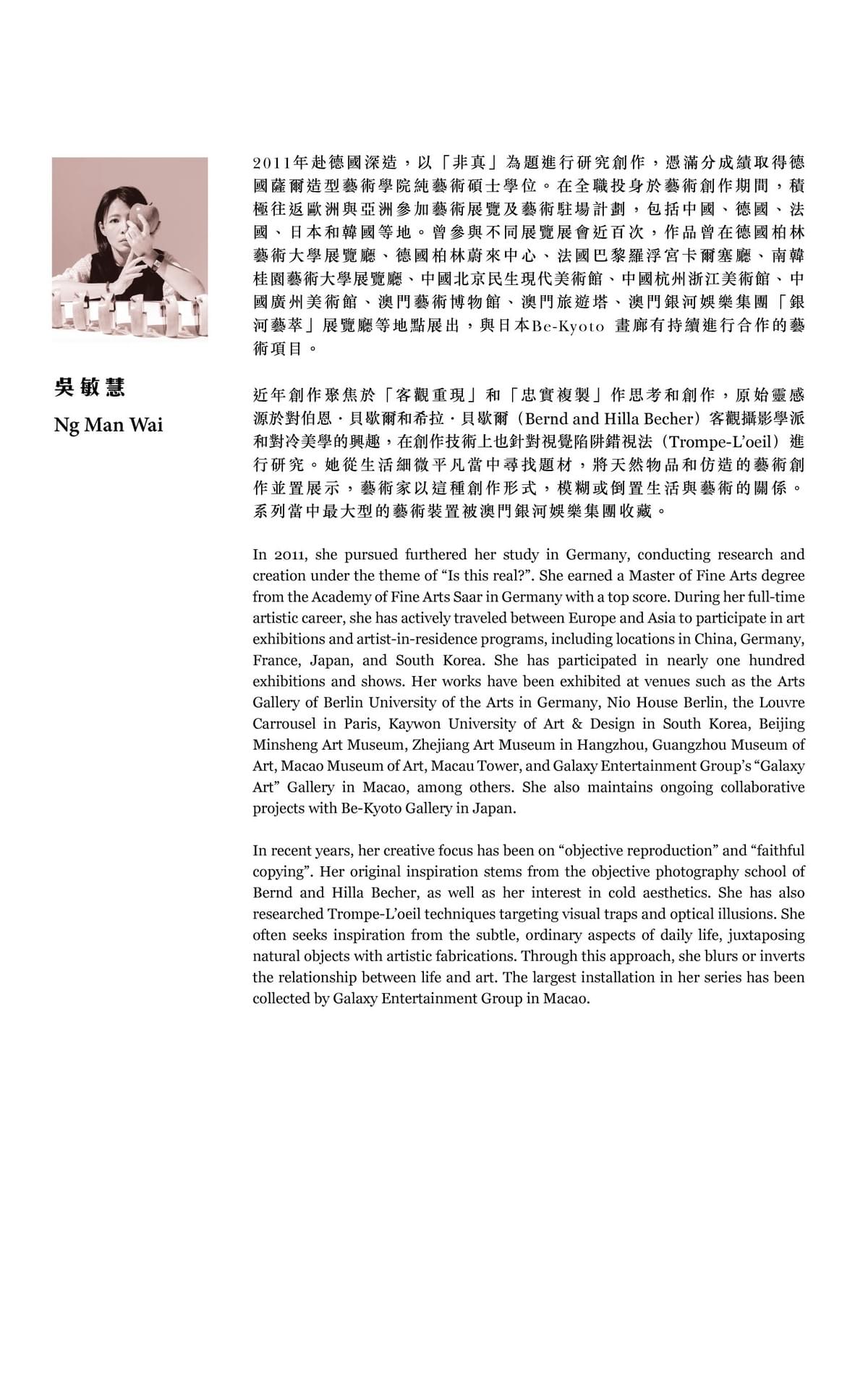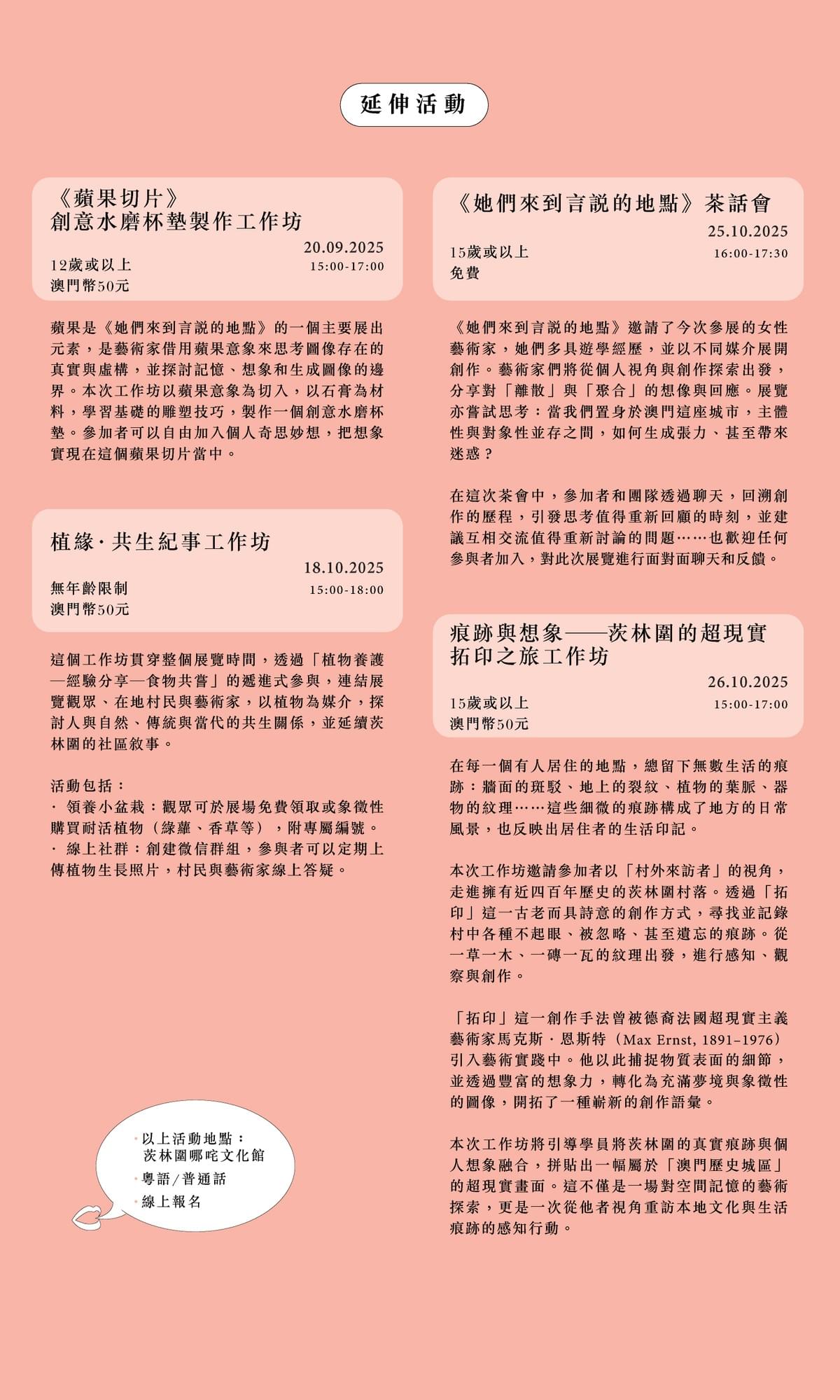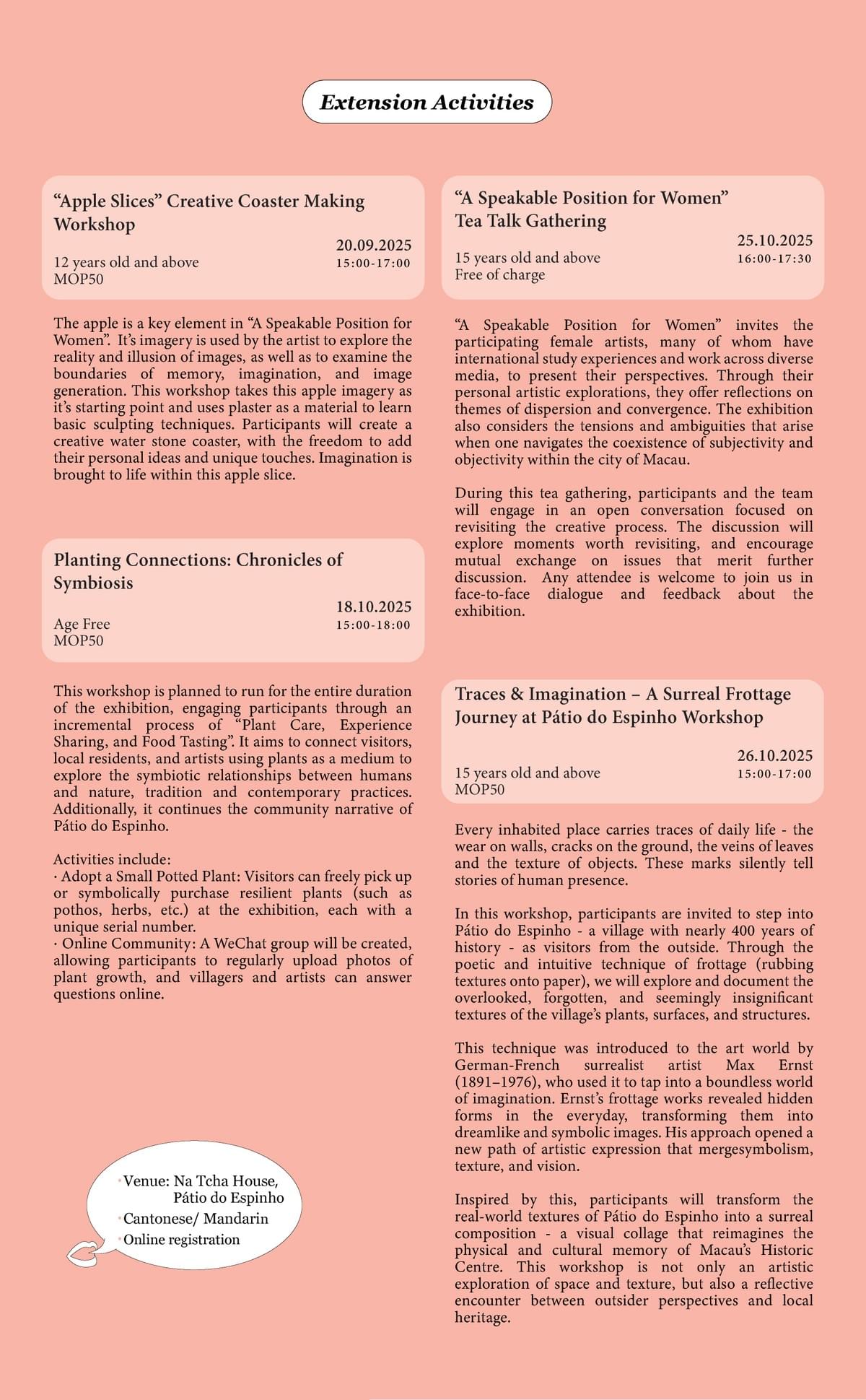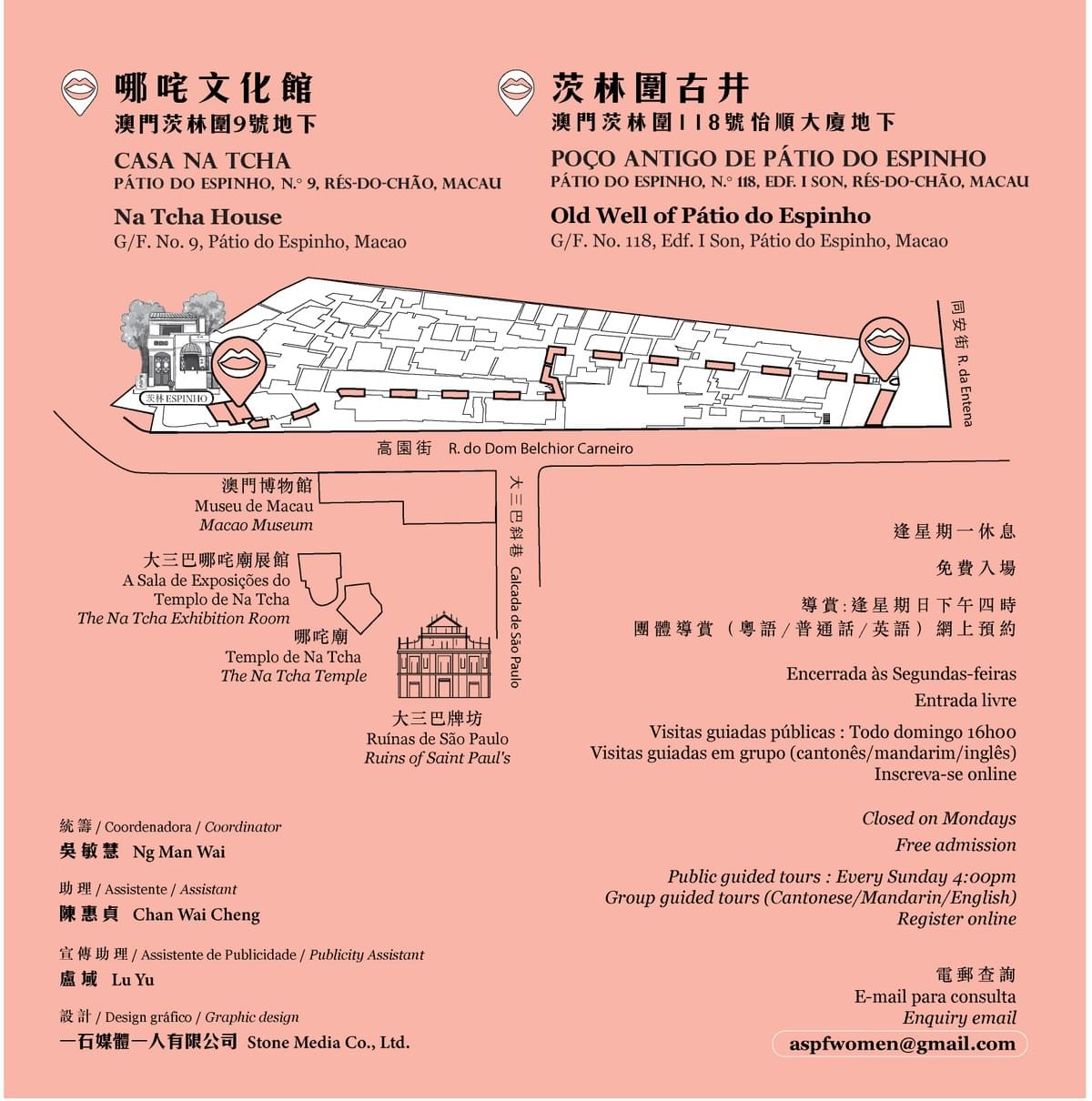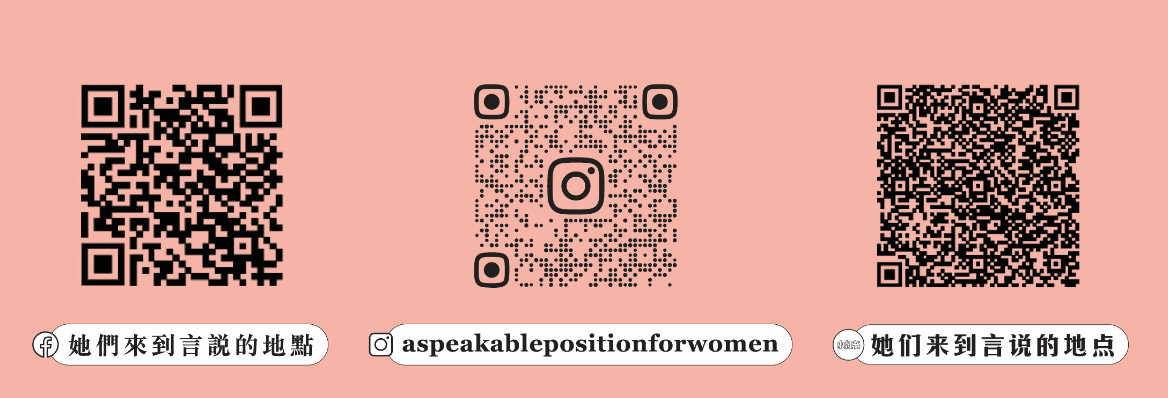『 她們來到言說的地點 』
藝文薈澳:澳門國際藝術雙年展2025(本地策展計劃)
猶如置身於澳門這座城市時並存的主體性(「我」?)與對象性(「他者」?)之間的張力與迷惑,世界的鏈接和斷裂會同時發生已經成為我們共同的新現實,無力理解他人或許是面臨的最具挑戰的情感障礙,這也揭示了他者與我的關繫斷層。在公共討論中其實很難深入個人的身體、身份認知,而深入個人經歷的時候,共同經驗場域就動搖了,我們最後都只能抓住自己最迫切的問題。這個方案協同七位具備遊學背景且從事各異媒介的女性藝術家,從她們個體創作的自我目光與追問出發,它必然呈現出關於離散、聚合的想象或導向;而串聯每位藝術家作為女性主體基於曾經及當下的日常探索自我話語的各自作品,或許更能不斷重新質疑我們用來思考主體性生活的這些範疇。
身體/身份的流動性更顯著地體現在吳敏慧和李佳寶的參展作品中。佳寶的影像裝置《魷魚地圖》是她從夏威夷群島收集白沙和黑沙,把它們做成某些國家的形狀,讓魷魚在兩個「國家」之間無需簽證地遊來遊去,將沙子從一側帶到另一側。這也指向了她自己作為一個移民,背負兩種文化包袱,試圖融入,卻像魷魚一樣:它身上白中有黑,黑中有白,覺得自己偽裝得完美無瑕!而敏慧則通過將自己近20年來遊歷70個國家的門票收藏轉化成《第二身 — 門票系列》,並置原件與擬真仿品,從中不僅透露了她對藝術複製(甚麽是真實?)的反觀,也承載了她作為一位澳門女性的思辨性成長。
同為澳門女性、主要居住在巴黎的何沛珊,此次展出油畫及錄像《兩相思》,靈感源自宋朝詩人李禹的一首同名、關於遊子出門在外思念家鄉親友的詩,似乎對照着她自身的某種緬懷性思緒與寄托。涉及到離家更近的關切,一直圍繞「家庭女性」或「母職」且討論在其有限生存條件中進行創造的司徒儉,此次命名作品為《非算法的生命——家的紋樣,家庭場域中的女性創作主體性研究與藝術實踐》,直接選擇日常生活物件如蒸盤、舊地毯等家用器物來構成一個油畫裝置的現場。
法國精神分析學家朱莉婭.克里斯蒂娃在《黑太陽:抑郁與憂郁》中寫到:「在女性身上,行為的轉變受到更多的壓抑,較難實現。因此,當這樣的轉變發生時,它往往表現得更為激烈。因為客體的喪失對於女性而言是無法挽回的,哀悼對於她而言更加困難,或者說是無法完成。」羅藹盈和梁潔雯分別在各自作品中儀式化了某種自我「哀悼」。藹盈的《尋我於太虛》靈感源自澳門哪咤廟門聯「何者是前身,漫向太虛尋故我」,在這個行為錄像中,她以自己的身體為媒介,以低溫蠟為語言,「表演」着疼痛,展開一場對「前身」與「自我」的追問。梁潔雯則以國畫《都市圍裙》描畫了作為雙職女性藝術家被工作與家務佔據全部時間的無法掙脫的那個圈。
關於更困難地處理喪失——如果並未讓其成為症狀,恰恰相反,而是把這個問題替換,那便找回「我的方塊」。對於姚詠思而言,透過描寫「時間」的概念得以述說她生活的種種片段,從而把流動不可預見的認知凝固成可視的痕跡,作品《述(No.6)》便是截取自己某段生命經歷,借用獨性且具象的線,反覆描寫在半透明質感宛如肌膚的承載體之上,她選擇將流動轉換成靜止……
就像來到澳門的訪客(「他者」)都會(被)歷經一遍仿似「我來自哪裡」的身份問題程序,倘若這七位藝術家作為一種「分類」——而一種分類,基本上就是以它所排除的東西為基礎的,正是從這個被分類排除在外的位置的功能中,實踐者的創造性及其欲望才得以生成,從而超越任何分類,以趨向差異。在這個展覽中,她們共享的女性身份與經歷更多是一種「背景」,而背景本身並不產生每個「她」的所在之處及構成之處,她們的作品才構成了從中向我們言說的地點:「一個女性創作者應當堅持自己的表達是根植於女性經驗的……」(阿美利亞.瓊斯《後女性主義、女性主義的快感和身體化藝術理論》)。
王景 策展人
展期:05/09-31/10/2025 (逢星期一休息)
開幕日及時間:二零二五年九月四日下午六點正 (星期四)
開放時間:11:00 - 18:00
免費入場
導賞:逢星期日下午四時
場地及地址:
1)哪咤文化館 (澳門茨林圍9號地下)及
2)茨林圍古井展館 (澳門茨林圍118號怡順大廈地下)
查詢電話及電郵:aspfwomen@gmail.com
策展人 : 蔣靜華、王景
展出藝術家:何沛珊、姚詠思、梁潔雯 、李佳寶、羅藹盈、吳敏慧、司徒儉
“A Speakable Position for WOMEN”
Art Macao: Macao International Art Biennale 2025 (Local Curatorial Project)
Just as when one is in the city of Macao, the tension and confusion between subjectivity (“I”) and objectivity (“the other”) coexist, the connection and disconnection of the world occur simultaneously, which has become our new common reality. The inability to understand others may be the most challenging emotional obstacle we are facing, which also reveals the rift in the relationship between the other and me. In public discussions, it is difficult to delve into an individual’s body and identity, and when delving into personal history, the common experience field is shaken. In the end, we can only grasp our most urgent problems. This project collaborates with seven female artists with a background of studying abroad and working in various media. Starting from their individual creative self-gaze and inquiries, it is bound to present an imagination or orientation about dispersion and aggregation. By connecting each artist’s works as a female subject based on their past and present daily explorations of self-expression, it may constantly re-question the scopes we use to think about the life of the subject.
The fluidity of body/identity is more prominently reflected in the works of Ng Man Wai and Li Jia Bao in this exhibition. Jia Bao’s video installation Squid Map is made by collecting white and black sand from the Hawaiian Islands and shaping them into the forms of certain countries, allowing squids to swim freely between the two “countries” without a visa, carrying sand from one side to the other. This also points to her own experience as an immigrant, carrying the burden of two cultural backgrounds, trying to integrate but like a squid: it has white and black on its body, thinking it has disguised itself perfectly! While Man Wai transforms her collection of tickets from traveling to 70 countries over the past 20 years into Doppelganger - The Series of Tickets - juxtaposing the original tickets with realistic replicas, revealing not only her reflection on art reproduction (what is real?) but also her speculative growth as a Macao woman.
Both Macao women and mainly residing in Paris, Ho Pui San’s oil painting and video Unite in Thought is inspired by a same-named poem by the Song Dynasty poet Li Yu about a traveler missing his hometown and relatives. It seems to correspond to her own nostalgic thoughts and consolations. Regarding concerns closer to home, Situ Jian, who has always been discussing creation within the limited living conditions of “family women” or “motherhood”, directly names her work A Non-Algorithmic Life - Research and Artistic Practice on Women’s Creative Subjectivity in the Domestic Sphere, and directly chooses daily objects such as steaming trays and old carpet to form an oil painting installation scene.
Julia Kristeva, a French psychoanalyst, wrote in her book Black Sun: Depression and Melancholia: “For women, the transition to action is more inhibited and difficult to achieve. Therefore, when such a transition occurs, it often manifests more intensely. Because the loss of the object is irreparable for women, mourning is more difficult for her, or rather, impossible to complete.” Luo Ai Ying and Leong Kit Man ritualize a certain self-mourning in their respective works this time. Ai Ying’s Seeking Myself in the Universe is inspired by the couplet at the gate of the Na Tcha Temple in Macao, “Who is my former self? Seek it in the universe.” In this performance video, she uses her body as a medium and low-temperature wax as language, “performing” pain and launching a quest for “former self” and “myself”. While Leong Kit Man, on the other hand, depicted the inescapable circle that consumes all the time of a dual-income female artist with her Chinese painting “Urban Apron”.
Regarding more difficult mourning - if it is not made into a symptom, but rather replaced by this problem, then “my square” is found. For Io Weng Si, through depicting the concept of “time”, she is able to narrate the various fragments of her life, thereby solidifying the fluid and unpredictable cognition into visible traces. Her work Describe (No. 6) is a portrayal of a certain period of her life experience, using unique and concrete lines repeatedly drawn on a semi-transparent carrier that resembles skin. She chooses to transform the flow into stillness...
Just as visitors (“the other”) to Macao all go through a process of questioning their identity “Where am I from?”, if these seven artists are regarded as a “category” - and a category is essentially based on what it excludes, it is precisely from this position of being excluded from the category that the creativity and desires of the practitioners are generated, thus transcending any classification and moving towards difference. That is, in this exhibition, their shared female identity and experiences are more of a “background”, and the background itself does not produce the location and composition of each “her”. It is their works that constitute the place from which they speak to us: “A female creator should insist that her expression is rooted in female experience...” (Amelia Jones, Postfeminism, Feminist Pleasure, and Corporeal Art Theory).
Wang Jing Curator
Date: 05 September - 31 October 2025 (Closed on Mondays)
Opening Hours: 11:00 - 18:00
Opening: 04 September (Thursday) 6:00 PM
address:
1) Na Tcha House (G/F. No. 9, Pátio do Espinho) &
2) Old Well of Pátio do Espinho (G/F. No. 118, Edf. I Son, Pátio do Espinho, Macao)
Free admission
Curators: Cheong Cheng Wa, Wang Jing
Artists: Ho Pui San, Io Weng Si, Leong Kit Man, Li Jia Bao, Luo Ai Ying, Ng Man Wai, Situ Jian
